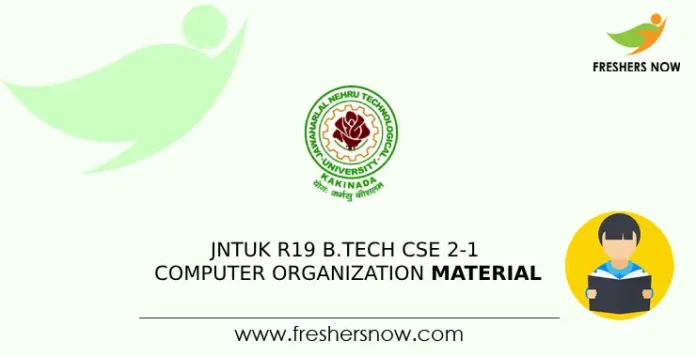
JNTUK R19 B.Tech CSE 2-1 Computer Organization Material/ Notes PDF Download: Are you a B.Tech CSE 2-1 student at JNTUK R19? Need study JNTUK R19 B.Tech CSE 2-1 Computer Organization Material. You’re in luck! Our materials cover everything you need to know. Learn about computer arithmetic principles, how CPUs work (like RTL, ALU, and Instruction Cycle), and different CPU designs. Understand memory systems, I/O organization, and how Multiprocessor Systems and Pipelining work. Our notes are easy to understand and designed to help you succeed. Plus, you can download the PDF for convenient studying.
JNTUK R19 B.Tech CSE 2-1 Computer Organization Material – Units
| No. Of Units | Name of the Unit |
| Unit – 1 | Basic Structure of Computers, Computer Arithmetic |
| Unit – 2 | Register Transfer Language and Microoperations, Basic Computer Organization, and Design |
| Unit – 3 | Central Processing Unit, Microprogrammed Control |
| Unit – 4 | Memory Organization, Input-Output Organization |
| Unit – 5 | Multi Processors, Pipeline |
Unit 1 Syllabus PDF Download | JNTUK R19 B.Tech CSE Computer Organization Material
Basic Structure of Computers: Basic Organization of Computers, Historical Perspective, Bus Structures, Data Representation: Data types, Complements, Fixed Point Representation. Floating, Point Representation. Other Binary Codes, Error Detection Codes.
Computer Arithmetic: Addition and Subtraction, Multiplication Algorithms, Division Algorithms.
| JNTUK R19 B.Tech CSE 2-1 Computer Organization Material – PDF Download | |
| To Download The JNTUK R19 B.Tech CSE 2-1 Computer Organization Unit 1 Notes PDF | Download PDF |
Unit 2 Syllabus PDF Download | JNTUK R19 B.Tech CSE Computer Organization Material
Register Transfer Language and Microoperations: Register Transfer language. Register Transfer Bus and Memory Transfers, Arithmetic Micro operations, Logic Micro Operations, Shift Micro Operations, Arithmetic Logic Shift Unit.
Basic Computer Organization and Design: Instruction Codes, Computer Register, Computer Instructions, Instruction Cycle, Memory – Reference Instructions. Input –Output and Interrupt, Complete Computer Description.
| JNTUK R19 B.Tech CSE 2-1 Computer Organization Material – PDF Download | |
| To Download The JNTUK R19 B.Tech CSE 2-1 Computer Organization Unit 2 Notes PDF | Download PDF |
Unit 3 Syllabus PDF Download | JNTUK R19 B.Tech CSE Computer Organization Material
Central Processing Unit: General Register Organization, STACK Organization. Instruction Formats, Addressing Modes, Data Transfer and Manipulation, Program Control, Reduced Instruction Set Computer.
Microprogrammed Control: Control Memory, Address Sequencing, Micro Program example, Design of Control Unit.
| JNTUK R19 B.Tech CSE 2-1 Computer Organization Material – PDF Download | |
| To Download The JNTUK R19 B.Tech CSE 2-1 Computer Organization Unit 3 Notes PDF | Download PDF |
Unit 4 Syllabus PDF Download | JNTUK R19 B.Tech CSE Computer Organization Material
Memory Organization: Memory Hierarchy, Main Memory, Auxiliary Memory, Associative Memory, Cache Memory, Virtual Memory.
Input-Output Organization: Peripheral Devices, Input-Output Interface, Asynchronous data transfer, Modes of Transfer, Priority Interrupts, Direct Memory Access.
| JNTUK R19 B.Tech CSE 2-1 Computer Organization Material – PDF Download | |
| To Download The JNTUK R19 B.Tech CSE 2-1 Computer Organization Unit 4 Notes PDF | Download PDF |
Unit 5 Syllabus PDF Download | JNTUK R19 B.Tech CSE Computer Organization Material
Multi Processors: Introduction, Characteristics of Multiprocessors, Interconnection Structures, Inter Processor Arbitration.
Pipeline: Parallel Processing, Pipelining, Instruction Pipeline, RISC Pipeline, Array Processor.
| JNTUK R19 B.Tech CSE 2-1 Computer Organization Material – PDF Download | |
| To Download The JNTUK R19 B.Tech CSE 2-1 Computer Organization Unit 5 Notes PDF | Download PDF |
JNTUK R19 B.Tech Computer Organization Material – Outcomes
- Number Systems and Binary Operations: Computers use different number systems like binary (base-2), decimal (base-10), etc. Binary addition and subtraction are fundamental operations in computing, where numbers are added or subtracted using rules similar to those in decimal arithmetic but with only two digits: 0 and 1.
- CPU Architecture and Functionality: The Central Processing Unit (CPU) is like the brain of a computer. It carries out instructions from programs by performing operations like arithmetic, logic, and data movement. It consists of components like the Arithmetic Logic Unit (ALU), Control Unit (CU), and registers, each responsible for specific tasks in executing instructions.
- I/O and Memory Organization: Input/Output (I/O) and memory are crucial parts of a computer system. I/O devices like keyboards, mice, and monitors allow users to interact with the computer, while memory stores data and instructions for the CPU to access quickly. Memory is organized hierarchically, with faster but more expensive types (like cache) closer to the CPU and slower but cheaper types (like disk storage) farther away.
- Parallel Processing and Pipelining: Parallel processing involves using multiple processors to perform computations simultaneously, which can greatly speed up tasks. Pipelining is a technique where the CPU divides instruction execution into stages to process multiple instructions simultaneously, improving overall efficiency.
- Inter-processor Communication: In systems with multiple processors, inter-processor communication is essential for coordinating tasks and sharing data between processors. This can be achieved through techniques like shared memory, message passing, or dedicated communication channels, ensuring effective collaboration between processors in a system.
For more details about JNTUK R19 B.Tech CSE 2-1 Computer Organization Material and other materials follow our official website Freshersnow.com.



